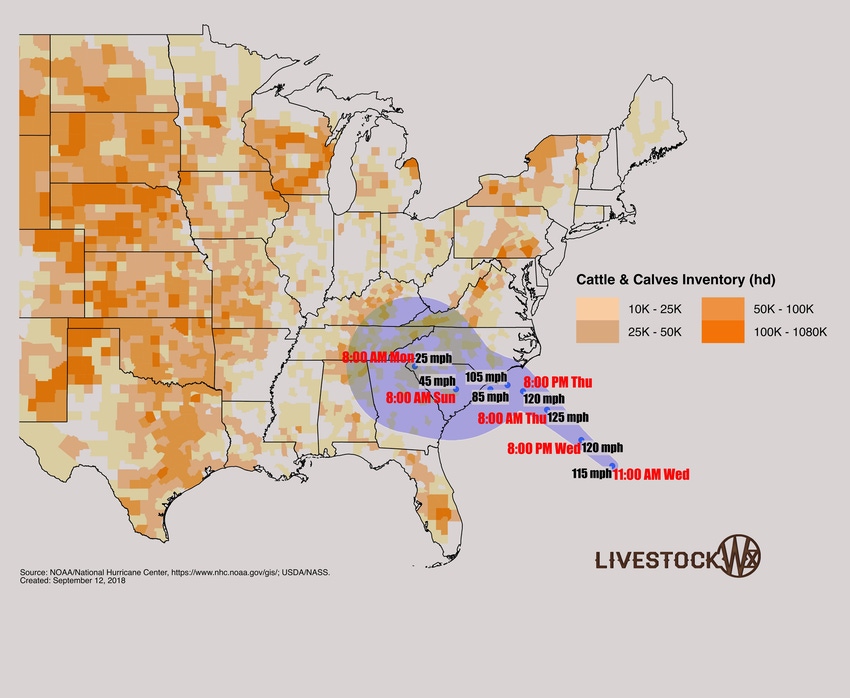Hurricane Florence to leave large footprint on cattle and calves in Southeast
Florences’s path is uncertain, but her impact on cattle producers and their livestock isn’t.
September 13, 2018

By Chad McNutt and John Feldt
As people evacuate large areas of the Southeast coast, beef producers and other livestock producers are bracing for the worst. Hurricane Florence will make landfall along the Southeast U.S. coast as a major hurricane late Friday or early Saturday and the damage is expected to be substantial.
Florence has the potential for major impacts on livestock producers due to damaging winds, record rainfall and widespread inundation and flooding. Figures 1 shows the forecast track as of Wednesday afternoon and the cone of uncertainty along with inventory of cattle and calves based on the 2012 USDA NASS census data. As of this writing, approximately 5.4 million head of cattle and calves are in the path of Hurricane Florence.

Figures 1 shows the forecast track as of Wednesday afternoon and the cone of uncertainty along with inventory of cattle and calves based on the 2012 USDA NASS census data.
According to information from the Texas Animal Health Commission, here are some things cattle producers can do to prepare for excessive flooding:
Before a flood
• Maintain an inventory.
Keep a current list of all animals on your farm.
Include their location and any records of vaccinations, testing and ownership.
• Have identification for all animals.
Make sure animals have some form of permanent identification (e.g., ear tags, tattoos).
Ensure animals are properly vaccinated before exposure to floodwaters.
During a flood
• Be aware animal behavior may change before, during and even after a disaster.
If you must evacuate, ensure your family’s safety first.
If there is time - move or evacuate livestock and horses to higher ground.
If there is no other alternative, keep gates or buildings open so they can escape high water.
Establish escape routes to safe locations (higher elevation).
Place your contact number and the name and number of your veterinarian on a building.
After a flood
• Assess your animals and building structures.
Survey damage to your barns and other structures; assess the stability and safety.
Examine your animals closely; contact your veterinarian if you observe injuries or signs of illness.
• Return animals only after the threat has passed and the safety of buildings or the area has been assessed.
Release animals in a safe and enclosed area until familiarity of the surroundings can occur.
• Provide non-contaminated feed or water.
Provide clean, uncontaminated water.
Do not feed flood damaged or moldy feed or hay.
Do not use any feed or forage that may have been contaminated by chemical or pesticides.
• Animal disposal.
Record any animal deaths.
Check with your state or local authorities for proper disposal methods for animal carcasses.
• Prevent illness.
Keep animals away from flood waters which may contain harmful bacteria or chemicals.
Monitor animals daily for signs of illness.
Be sure to keep updated on the latest weather situation through information issued by official government sources. You can also obtain a snapshot of information at www.rainforecaster.com.
McNutt and Feldt are principles in Livestock Weather, a leading source of weather content specific to the livestock industry. Contact them at www.livestockwx.com.
You May Also Like


.png?width=300&auto=webp&quality=80&disable=upscale)
